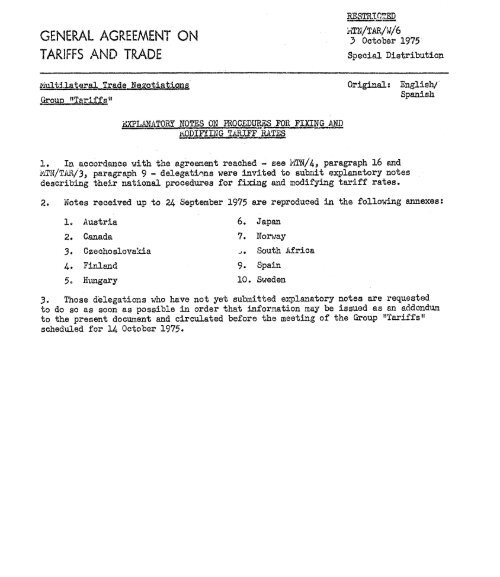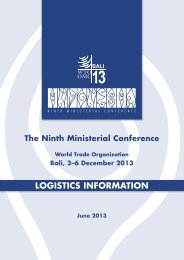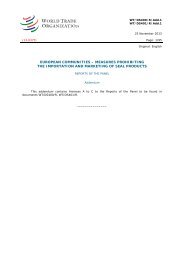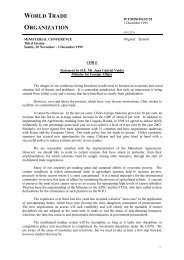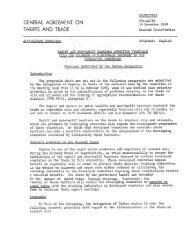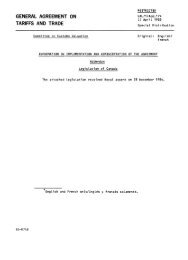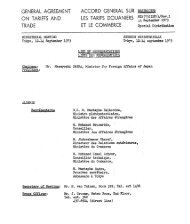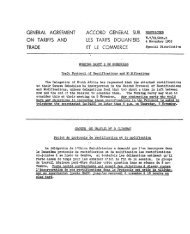GENERAL AGREEMENT ON - World Trade Organization
GENERAL AGREEMENT ON - World Trade Organization
GENERAL AGREEMENT ON - World Trade Organization
You also want an ePaper? Increase the reach of your titles
YUMPU automatically turns print PDFs into web optimized ePapers that Google loves.
<strong>GENERAL</strong> <strong>AGREEMENT</strong> <strong>ON</strong><br />
TARIFFS AND TRADE<br />
RESTRICTED<br />
MTN/TAR/W/6<br />
3 October 1975<br />
Special Distribution<br />
Multilaeral <strong>Trade</strong> Negotiation Original: English/<br />
Spanish<br />
EXPLANATI<strong>ON</strong> NOTES <strong>ON</strong> PROCEDURES FOR FIXING AND<br />
MODIFYCING TARIFF RATES<br />
1. In accordance with the agreement reached - see MTN/4, paragraph 16 and<br />
MTN/TAR/3, paragraph 9 - delegations were invited to submit explanatory notes<br />
describing their national procedures for fixing and modifying tariff rates.<br />
2. Notes received up to 24 September 1975 are reproduced in the following annexes:<br />
1. Austria<br />
2. Canada<br />
3. Czechoslovakia<br />
4. Finland<br />
5. Hungary<br />
6. Japan<br />
7. Norway<br />
8. South Africa<br />
9. Spain<br />
10. Sweden<br />
3. Those delegations who have not yet submitted explanatory notes are requested<br />
to do so as soon as possible in order that information may be issued as an addendum<br />
to the present document and circulated before the meeting of the Group "tariffs"<br />
scheduled for 14 October 1975.
MTN/TAR/W/6<br />
Page 2<br />
Annex 1<br />
AUSTRIA<br />
In Austria the general tariff rates are fixed bindingly by the Customs Act<br />
of 1958, as ameded. The fixing and/or the modification of a tariff rate<br />
requires parliamentary approval as well as the publication of this decision in<br />
the Pederal Law Gazette; this procedure is the procedure required for the<br />
enactment of a bill by the relevant provisions of the Austrian Constitutional<br />
Law.<br />
In addition, the Federal Minister for Finance is authorized by the Customs<br />
Act to reduce or suspend duties in general or in specific cases on account of<br />
price policies for reasons of supply or as a solution to temporary crises; such<br />
reductions or suspensions can only be made on a temporary basis. The Federal<br />
Minister for Finance has used this authority in specific cases for the duration<br />
of the existence of the legal basis. Such conditional .anḏ in duration -<br />
limited measures in favour of imported goods are only made upon request by the<br />
importer who has to bind himself to forward the amount of the tariff reduction<br />
to the Austrian consumer. The fulfilment of this obligation is reviewed. The<br />
continued validity of the autonomous tariff rates as well as of the contractual<br />
GATT-rates is in no way affected by the granting; from time to time, of such<br />
unilateral and temporary tariff reductions.<br />
The contractual rates agreed upon in the framework of the General Agreement<br />
are subject to the same internal procedures as the autonomous tariff rates;<br />
i.e. they have to be approved by Parliament and to be published in the Federal<br />
Law Gazette.
Page 3<br />
Annex 2<br />
CANADA<br />
The Customs Tariff is an Act of Parliam'ent. It consists basically of three<br />
sets of rates: Preferential Tariff rates for Commonwealth countries; M.f.n.<br />
Tariff rates for most other countries and General Tariff rates which arml to<br />
goods from a few countries and are not significant in trade terms'. In addition,<br />
reduced rates have been extended to a wide range of products imported. from<br />
designated developing countries under the General System of Preferences (GPT).<br />
Finally,.-for certain products, there are special rates for goods from. some<br />
Commonwealth countries under bilateral trade agreements.<br />
Some changes in tariff items, normally reductions in tariffs, are introduced<br />
at the time of an annual budget on a -permanent basis.<br />
Reductions in m.f.n. rates may be made by Order in Council as compensation<br />
for concessions granted by other countries.<br />
Tariff changes of a. temporary nature may be introduced in annual budgets<br />
(e.g. the Budeet of 19 February 1973 introduced temporary reductions on a<br />
range of products) or by Order in Council (section 273 of the Customs Act<br />
authorizes temporary reductions in tariffs on goods that are im-ported for use in<br />
manyfacturin-' in Canada and section 12 of the Customs Tariff authorizes temporary<br />
reductions in duties on most chenicals and plastics).
MTN/TAR/W/6<br />
Page 4<br />
Annex 3<br />
CZECHOSLOVAKIA<br />
Under the new Czechoslova Customs Law No. 44 of. 24 April 1974 of Law<br />
Gazette tariff rates are fixed and can be modified by Government Decree. Under<br />
this Law tariff rates can be modified also by international agreements.<br />
The Czéchoslovak Customs Tariff in force was issued by Government Decree.<br />
No. 32 of 1974 of Law Gazette. Its last version containing seventh supplement<br />
was published by the Internationa. Customs Tariffs Bureau in Brussels in 1971<br />
as its fourth edition.
MTN/TA/W/6<br />
Page 5<br />
Annex 4<br />
In the current Customs Tariff of Finland there is only one main category of<br />
duties, the general duty. This duty is. principally, applied to imports from all<br />
countries.<br />
Another category is constituted by GATT duties, of which the last change<br />
was effected in 1968; the changes have been established in Finland by decree.<br />
The general duties were reformed in 1968 as well; they are either equal to the<br />
duty based on the GATT agreement or under it. Imports from GATT countries are,<br />
accordingly, subject to the general rate of duty as well.<br />
General rate of duty<br />
In Finland the general rate of duty is laid down by the Parliament by<br />
legislation. Duties deviating from the general duties are the following:<br />
1. Import levies<br />
1.1 For reasons relating to agricultural policy, most duties mentioned in<br />
chapters 1-24 are termed import levies. Their rate is laid down, in the<br />
same way as that of duties, with the exception that the preparatory body<br />
is composed of those representing the agricultural interests. GATT<br />
commaitrments are subject to the same arrangements as duties.<br />
1.2 The Ministry of Finance retains the right to effect changes to part of<br />
import levies (i.a. meat, dairy produce, fats) according as the world-market<br />
prices are fluctuating (variable import levies). Changes take place<br />
.relatively frequently at times even every week.<br />
1.3 The Council of the State is. furthermore, empowered to provisionally<br />
reducing duties and import levies for certain foodstuffs for the purpose of<br />
safeguarding. the interests or economic and business life. Among these<br />
foodstuffs are coffee, certain fruit and vegetaltes. Provisional reductions<br />
are, as a rule. in force for a period varying from a few months to half a<br />
year.<br />
2. T-duties (industrial rate of duty)<br />
2.1 T--duties are Customs concessions granted for certain raw materials for the<br />
benefit of home industry. The Parliament lays down t--duties.. like other<br />
duties, in the Customs Tariff Act.
MTN/TAR/W/6<br />
Page 6<br />
2.2 T-duties come into being after representatives of industrial life have<br />
submitted a relative application to the Board of the Customs Tariff, the<br />
body preparing the Customs Tariff.<br />
2.3 T-duties are noted in respective headings in the Customs Tariff Act.<br />
2.4 To be entitled to the use of t-duty an industrial enterprise has to lodge a<br />
relative application to the District Customs Office, which makes a decision<br />
on the entitlement to the concession for one calendar year at a time.<br />
2.5 The t-duty and exemption from duty are applied to goods referred to in the<br />
note, irrespective of their country of origin<br />
3. E-duties<br />
3.1 E-duties constitute another category of Customs concessions laid down for<br />
safeguarding the functioning of home industry. This concession is. in the<br />
first place, applied to machinery and apparatus necessary for productive<br />
activities. 'The Parliament lays down e-duties in an equal way as other<br />
general duties.<br />
3.2 The establishment of e-duties is, in conformity with t-duties, preceded by<br />
applications to be submitted by industrial circles.<br />
3.3 F-duties are marked at the side of the general duty in the Customs Tariff<br />
Act. In a few cases., even e-duty may be indicated by a note.<br />
3.4 E-duty may be applied to a product only if corresponding production does not<br />
exist in Finland at industrial level.<br />
3.5 Importers have to apply to the Board of Customs for a certificate entitling<br />
them to the application of e-duty. The Board of Customs makes, in general,<br />
a relative decision for half a year at a time.<br />
3.6 E-duty is applied to goods irrespective of their country of origin.<br />
4. Free-tradeagreements<br />
4.1 All tariff reductions incorporated in the free-trade agreements have been<br />
calculated as gradual reductions out, of the general duty.<br />
4.2 The oldest free-trade agreements concluded by Finland are the FINEFTA<br />
agreement and a corresponding agreement with the Soviet Union. On the basis<br />
of these agreements almost all imports from these areas are duty free.
MTN/TAR/W/6<br />
Page 7<br />
4.3 The tariff reductions incorporated in the latest free-trade agreements..<br />
those concluded with EEC countries andcertain CMEA countries, are calculated<br />
out of the general duty. For EEC reductions. the basic duty is equal to<br />
the duties in force on I January 1972 and for CMEA countries on<br />
I January 1974. Imports from the two areas are exempt from duties from<br />
1 July 1977 onwards ahd for certain goods from 1 January 1985 on.<br />
GSP-duties<br />
In Finland GSP--duties are neither connected with nor based on the general<br />
duties. although they have been laid down for each Customs Tariff heading and<br />
chapter. Concessions of Customs duties and import levies in respect of goods<br />
with provenance in developing countries are stipulated in a separate legislation.<br />
A brief description of regulations and procedures concerning GSP-duties will be<br />
given below.<br />
1.1 Goods originating in and imported from developing countries are exempt<br />
from duties and import levies by virtue of the relative Act (973/71.). The<br />
Council of the State prescribes by decree (974/71 with a few amendments)<br />
which countries quality as developing countries in the sense of this Act<br />
and which goods are eligible for exemption from duties and import levies.<br />
Commissioned by the Ministry of Finance a special negotiating groups which<br />
submits its Propositions to the Council of the State, prepares GSP-duties<br />
and their changes.<br />
1.2 The decree lists for each Customs Tariff heading and chapter the GSP goods<br />
that are exempt from duties or import levies in chapters 1-24 and stipulates<br />
that goods specified in chapters 25-29 in the Customs Tariff are duty free<br />
when imported from these countries, with the exception of certain products<br />
mentioned heading by heading,. This exemption from duties and import levies<br />
is a real, indirect immunity not governed by for instance quotas.<br />
1.3 The exertion from duties and import levies is subject to the condition<br />
that the importer submits a relative application. as part of the import<br />
documents, together with a certificate of origin conforming to the established<br />
model.<br />
1.4 Principally, all countries specified in the decree are entitled to GSP<br />
treatment but in Dractioe proper authorities in each developing country<br />
have to,before this, notify the Finnish Board of Customs of the authority<br />
thatmay. in respective developing countries, issue or endorse certificates<br />
of origin acceptable as documentary evidence and necessary for the<br />
exemption from duty, accompanied by the model stamps used by the competent<br />
authorities. The Board of Customs publishes a list of these countries and<br />
the authorities issuing certificates of origin.
MTN/TAR/W/6<br />
Page 8<br />
Annex 5<br />
HUNGARY<br />
In Hungary tariff rates are fixed and modified by the Council of Ministers<br />
without any indication for expiry, or if rates are fixed for a definite period<br />
it can be made by the Minister for Foreign <strong>Trade</strong> and Minister of Finance with<br />
the approval of the President of the National Board of Materials and Prices<br />
(National Supply and Pricing Office).<br />
Governmental regulation no. 4831967./XI-19 parraph 3 pertaining to. the<br />
above, is reproduced here:<br />
1. The Minister for Foreign <strong>Trade</strong> and the Minister of Finance are empowered<br />
by and with the approval of the National Supply and Pricing Office.<br />
(a) to determine customs quotas,<br />
(b) to decide which Woods shall be eligible for concessions;<br />
(c) to raise or reduce for specific periods the rates of customs duty<br />
set out in Columns I. II and III of the <strong>Trade</strong> Customs Tariff in respect<br />
of certain goods or to provisionally suspend such rates;<br />
(d) to amend the texts of the subheadings of the <strong>Trade</strong> Customs Tariff and<br />
the relevant rates of customs duty for specific periods;<br />
(e) to impose customs surcharges for specific periods.<br />
2. The Minister for Foreign <strong>Trade</strong> is empowered. by and with the approval of the<br />
Minister of Finance., to stipulate to which countries the rates of customs duty<br />
set out in Columns I and II of the <strong>Trade</strong> Customs Tariff shall be applied.<br />
3. The Minister of Finance is empowered, by and with the approval of the<br />
President of tile National Suply and Pricing Office and of the Minister for<br />
Foreign <strong>Trade</strong>. to specify the amount of the Customs Sales Tax.<br />
*Article 3, as issued in publication No. 192 (fifth edition) of the Brussels<br />
International Customs Tariffs Bureau. in English translated from the Hungarian<br />
Customs Tariff.
MTN/TAR/W/6<br />
Page 9<br />
Annex 6<br />
JAPAN<br />
1. The Japanese customs tariff consists of four categories of duty rates, i.e.<br />
(i) general rates, (ii) temporary rates. (iii) GATT rates and (iv) preferential<br />
(GSP) rates.<br />
The general rates. the temporary rates and the preferential (GSP) rates are<br />
introduced by national legislation; whereas the GATT rates are those provided for<br />
in conventions concluded with foreign countries.<br />
2. The general rates are defined as the basic rates of duty which shall<br />
continue to be effective on a long-term basis unless circumstances change.<br />
3. The temnorary rates are introduced by the Diet for the validity period of<br />
one year in principle. as a temporary exception to the general rates, taking into<br />
consideration such policy factors as foreign trade, domestic industries as well<br />
as consumers including commodity price problems, these temporary rates are<br />
subject to the annual review by the Diet.<br />
The temporary rate shall, when introduced, always supersede the general rate<br />
and, if the temporary rate is lower than the GATT rate, the former shall apply-<br />
4. Since the GATT rates are the rates provided for in conventions concluded<br />
with foreign countries, they shall supersede the general rates or the temporary<br />
rates stipulated by national legislation. However, if the temporary rate or the<br />
general rate is lower than the GATT rate., the former shall apply.<br />
5. The preferential (GSP) rates. unless suspended, shall have priority over any<br />
of the aforenentioned rates.
MTN/TAR/W/6<br />
Page 10<br />
Annex 7<br />
NORWAY<br />
1. The Norwegian Customas Tariff is based on the Brussels Nomenclature. The<br />
rates of duty as shown in the national sub-headings of the Tariff, are every year<br />
approved by the Parliament (The Storting) - as a rule on 1 January. At the same<br />
time The Storting gives the Directorate of Custcoms and Excise authority, (socalled<br />
Administrative Authority) to grant reductions or duty exemptions in<br />
respect of certain specified goods. A circular letter issued at the turn of the<br />
year, by the Directorate of Customs and Excise, covers the duty exemptions and<br />
reductions on the specified goods.<br />
2. Regulations on Customs duty reductions and exemptions in respect of<br />
specified. goods, may also appear in the Customs Tariff, in the form. of notes<br />
under the respective chapters and headings. In addition, the following general<br />
regulations on duty reductions and duty exemptions are in force;<br />
A. The Customs Department may authorize raw materials and auxiliary products<br />
for industry to be imported free of duty or at a lower duty than that<br />
provided for by the Tariff.<br />
B. The Customs Department may authorize the importation at the rate of NKr 0.30<br />
per kilogramm of volatile ethers cad esters falling within Chapter 29 and<br />
which; because they have been denatured or for another reason, are obviously<br />
unifitfor use as beverages.<br />
C. The Customs Department may, within the limits established by that Departments<br />
grant exemption from duty in respect of machines and apparatus and parts<br />
thereof. provided that articles of appreciably similar performance are not<br />
manufactured in Norway. The above Department shall decide what is to be<br />
considered as machines.. etc. for the purpose of the aforementioned<br />
exemptions.<br />
D. The Customs Department may, in certain cases, grant exemption from duty in<br />
respect of yarn, thread, cordage, ropes and plaited bands used for fishing<br />
and in respect of fibres for spinning used in the manufacture of such goods.
MTN/TAR/W/6<br />
Page 11<br />
SOUTH<br />
Annex<br />
AFRICA<br />
1. South Africa has a three-column customs tariff which makes provision for<br />
general, m.f.n. and preferential rates of duty. The general rates of duty are<br />
applicable to imports from those countries to which South Africa is.not bound to<br />
grant m.f.n. treatment in terms of GATT or a bilateral agreement. The<br />
preferential rates of duty are applicable to imports from certain member..countries<br />
of the British Commonwealth when these countries are specifically indicated in<br />
the preferential column.<br />
2. The Minister of Finance may, by notice .in the Government Gazette, amend the<br />
customs tariff<br />
(a) in order to give effect to a trade agreement or the amendment of a trade<br />
agreement, including the General Agreement on Tariffs and <strong>Trade</strong>;<br />
(b)<br />
in order to give effect to a recommendation of the Board of <strong>Trade</strong> and<br />
Industries;<br />
or<br />
(c) in order to give effect to an amendment to the Brussels Tariff Nomenclature.<br />
Any such amendment of the customs tariff shall lapse unless subsequently<br />
approved by Parliament.<br />
3. The Minister of Finance may also table in the House of Assembly proposals<br />
for the amendment of the customs tariffs. Such proposals have immediateeffect,<br />
pending their approval by Parliament.
MTN/TAR/W/6<br />
Page 12<br />
Annex 9<br />
SPAIN<br />
In Spain, tariff matters are regulated by the Tariff Act of 1 May 1960,<br />
published in the Official Gazette of 14 May 1960.<br />
In pursuance of that Act, a Government Decree of 30 May 1960 gave approval<br />
to the customs tariff governing imports of goods into the Peninsula and the<br />
Balearic Islands.<br />
As regards the procedure for modifying tariff rates, the above-mentioned Act<br />
of 1 May 1960, Article 6, fourth paragraph, empowers the Government to make<br />
partial modifications to the customs tariff, in accordance with the provisions of<br />
the latter.<br />
In accordance with this authorization the procedure established by the<br />
above-mentioned provisions for modifying tariff rates is the following:<br />
1. Public organizations and authorities and interested persons may formulate<br />
any appeals or requests that they consider appropriate in respect of the<br />
customs tariff by presenting them to the Ministry of <strong>Trade</strong> which has<br />
responsibility to deal with them. In addition, requests or proposals for<br />
modification may be made directly by the administration.<br />
2. The advisory body to the Ministry of <strong>Trade</strong> is the Tariff Board which makes a<br />
preceptive recommendation on any proposal for tariff reform. The Board<br />
comprises representatives of various Ministries (External Affairs, Finance,<br />
Agriculture, Industry and <strong>Trade</strong>), the Syndical <strong>Organization</strong>, the Chambers of<br />
Commerce, Industry and Navigation, the Official Agrarian Syndical Chambers<br />
and the National College of :.conomists.<br />
The work of the Board is assisted by subsidiary bodies, known as working<br />
parties: one for each section of the tariff; the production, consumption<br />
and trade sectors are directly represented in these.<br />
3. Any modifications. whether of a definitive or temporary character, are<br />
approved by governmerLt decrees, on a proposal by the Ministry of <strong>Trade</strong>.<br />
Apart from the above-mentioned authorization to make partial modifications<br />
to the tariff., the Government is also authorized., under Article 6, second<br />
paragraph of the Act, to suspend in full or in part the application of the<br />
corresponding customs duties for a period not exceeding three months in<br />
emergency circumstances of war, natural disaster., epidemic. or public<br />
calamity or to meet the needs of national supply.
MTN/TAR/W/6<br />
Page 13<br />
Annex 10<br />
SWEDEN<br />
The Swedish Customs Tariff is based on the Brussels Tariff Nomenclature.<br />
For practical work it has been combined with a statistical schedule which exists<br />
only in the form of a general "working tariff" with 7-digit sub-headings<br />
(4 digits from the Brussels Tariff Nomenclature plus 3 digits forming the<br />
statistical schedule). In the Swedish Customs Tariff the same rate (m.f.n. rate)<br />
is applied to imports from all countries (not only GATT countries), unless an<br />
overriding measure specifies a lower rate.<br />
Rates lower than the mif.n. rates are applied in the following cases:<br />
In accordance with paragraph 5 of the Swedish Customs Ordinance<br />
(1973:979) duty-free admission is Granted to imports from all countries of<br />
certain goods of a kind not manufactured in Sweden or manufactured there in<br />
small quantities only (e.g. certain chemical products or certain machinery).<br />
Such goods are enumerated in a Governmental proclamation (1974:417) with a<br />
validity of not more than two years.<br />
For most goods imported from developing countries or from Bulgaria or<br />
Romania the rates under the GSP apply (which means duty-free admission into<br />
Sweden).<br />
Goods originating in EFTA countries and covered by the EFTA Convention<br />
may be imported into Sweden free of duty.<br />
Goods originating in EEC countries and covered by the free-trade agreement<br />
with EEC may be imported into Sweden at lower rates than the m.f.n.<br />
rates (on 1 January 1974, 60 per cent of the m.f.n. rates).


